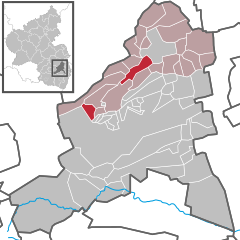Neuleiningen
| Neuleiningen | ||
|---|---|---|
|
||
| Coordinates: 49°32′31″N 8°8′22″E / 49.54194°N 8.13944°ECoordinates: 49°32′31″N 8°8′22″E / 49.54194°N 8.13944°E | ||
| Country | Germany | |
| State | Rhineland-Palatinate | |
| District | Bad Dürkheim | |
| Municipal assoc. | Grünstadt-Land | |
| Government | ||
| • Mayor | Franz Adam (CDU) | |
| Area | ||
| • Total | 9.07 km2 (3.50 sq mi) | |
| Population (2015-12-31) | ||
| • Total | 804 | |
| • Density | 89/km2 (230/sq mi) | |
| Time zone | CET/CEST (UTC+1/+2) | |
| Postal codes | 67271 | |
| Dialling codes | 06351, 06356, 06359 | |
| Vehicle registration | DÜW | |
| Website | www.neuleiningen.de | |
Neuleiningen is an Ortsgemeinde – a municipality belonging to a Verbandsgemeinde, a kind of collective municipality – in the Bad Dürkheim district in Rhineland-Palatinate, Germany.
On a foothill near the northern end of the Haardt, Neuleiningen gathers round the like-named castle at an elevation of some 300 m above sea level. To the west and southwest stretches the Palatinate Forest, to the northwest the North Palatine Highland, and to the east spreads the Upper Rhine Plain behind the Leiningerland’s vineyard-covered hills. Neuleiningen belongs to the Verbandsgemeinde of Grünstadt-Land, whose seat is in Grünstadt, although that town is itself not in the Verbandsgemeinde.
The hamlet of Neuleiningen-Tal (Tal means “dale” or “valley” in German), administratively part of Neuleiningen and consisting of only a few houses, lies south of the main centre at an elevation of 183 m, making it quite a bit lower than the main centre. Neuleiningen-Tal lies on the Eckbach. Downstream the valley opens onto a hilly landscape planted with vineyards on the western edge of the Upper Rhine Plain. It abuts the neighbouring municipality of Kleinkarlbach just to the east.
Neuleiningen – as with neighbouring Altleiningen a few kilometres away – draws its name from the noble family, the House of Leiningen, to whom the Leiningerland – also named for these counts – once belonged and who also built the castle in the 13th century. (The prefixes Alt— and Neu— simply mean “old” and “new” respectively). It was not long before a settlement had sprung up around this and begun to grow. Neuleiningen belonged until 1969 to the now abolished district of Frankenthal. The Verbandsgemeinde into which the municipality was later grouped was formed in 1972.
...
Wikipedia




